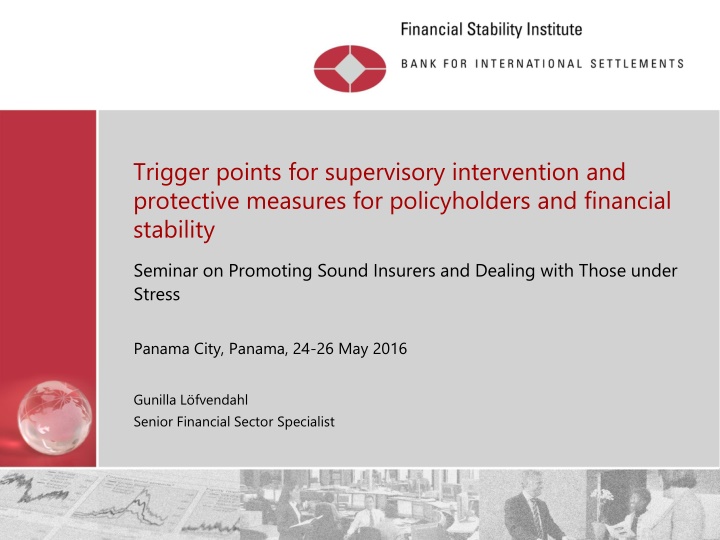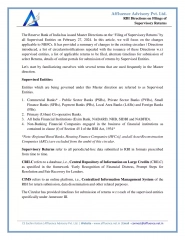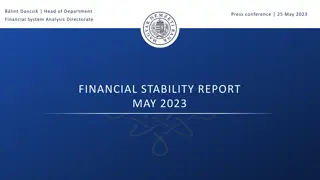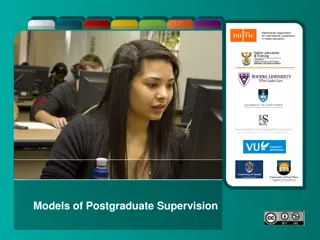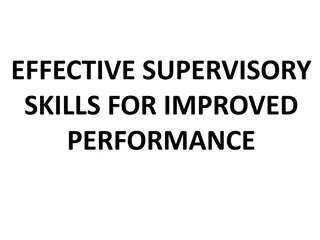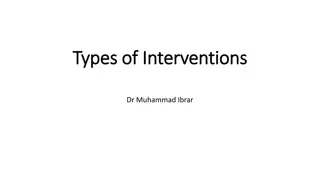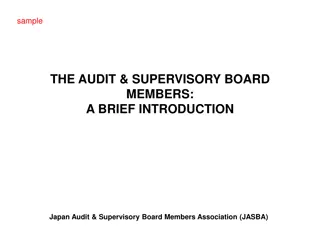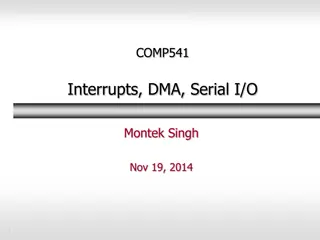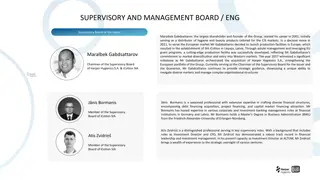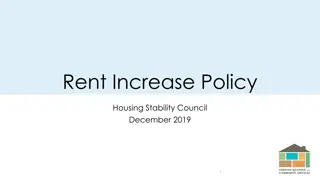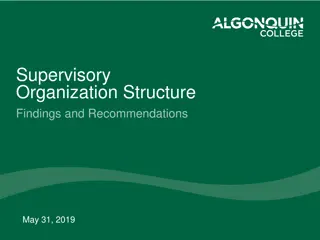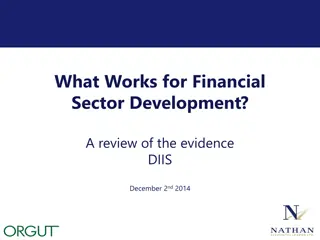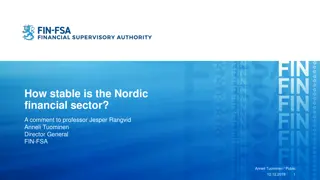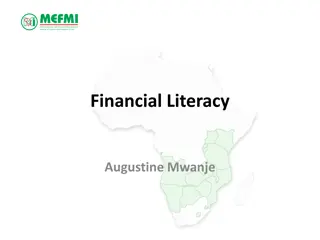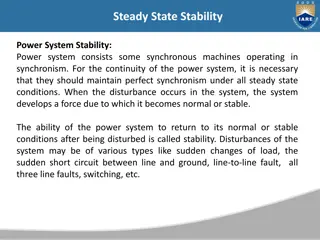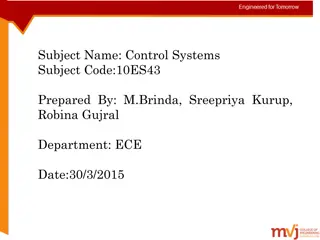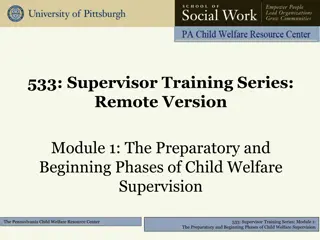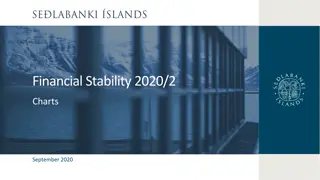Supervisory Intervention and Financial Stability
This seminar focused on trigger points for supervisory intervention, protective measures for policyholders, and maintaining financial stability in the insurance sector. Key topics included early identification of issues, supervisory enforcement, policyholder protection schemes, and more. Insurers facing challenges due to poor risk management, governance failures, and other typical situations were also discussed, emphasizing the importance of effective supervision to safeguard policyholders' interests and overall financial stability.
Download Presentation

Please find below an Image/Link to download the presentation.
The content on the website is provided AS IS for your information and personal use only. It may not be sold, licensed, or shared on other websites without obtaining consent from the author.If you encounter any issues during the download, it is possible that the publisher has removed the file from their server.
You are allowed to download the files provided on this website for personal or commercial use, subject to the condition that they are used lawfully. All files are the property of their respective owners.
The content on the website is provided AS IS for your information and personal use only. It may not be sold, licensed, or shared on other websites without obtaining consent from the author.
E N D
Presentation Transcript
Trigger points for supervisory intervention and protective measures for policyholders and financial stability Seminar on Promoting Sound Insurers and Dealing with Those under Stress Panama City, Panama, 24-26 May 2016 Gunilla L fvendahl Senior Financial Sector Specialist Restricted
Agenda Scope and objective of supervision Insurers in trouble and troubled supervisors Early identification and correction of problems Supervisory enforcement, recovery and resolution Winding-up, creditor hierarchy and policyholder protection schemes 2 Restricted
Scope and objective of supervision Protect the interests of the policyholders Detect insurance related risks through the supervision of insurance entities and groups Firm-specific supervisory measures aimed at mitigating or otherwise addressing these risks and their effects Protect the financial stability Detect emerging risks and other risks that are emanating from a wider perspective than the group, which can have an impact on the group and its entities, which could have an impact on the economy System-wide measures (many may be outside the scope of insurance supervision) Time dimension what actions are available and are fit for when? 3 Restricted
Insurers getting into trouble typical situations* Poor risk management and governance Failure to identify and manage risks arising from other entities in the group group risk, large exposures Lack of autonomy for companies belonging to a group Dominant leaders and lack of independence and control Inappropriate experience and skills of board members Heard behaviour and wrong incentives through remuneration Bad risk and corporate culture Under-pricing and provisioning Investment returns lower than provisioning or pricing assumptions Impact of external events (eg changes in mortality) Impact of catastrophic losses and other risk concentrations Reputational damage (also caused by other companies in the group), resulting in further problems * HIH (2001), European failures (2002), GFC (2008) 4 Restricted
Supervisory failings in seeing the problems Weak risk rating process and insufficient analysis and on-sites to review institutions Assumption that large and complex groups are always well-managed and controlled Inadequate solvency requirements on entity and group level Lack of resources and skills to understand: adequacy of liabilities risk management practices correlations and interactions of risks reinsurance arrangements Lack of group-wide supervision and cooperation with other supervisors Lack of macroprudential oversight and capturing of emerging risks Lack of supervisory tools, especially intervention powers, or the will to use them 5 Restricted
Group related issues Increasing complexity of international groups Risk management, corporate governance and internal control (coordinated, lack of independence/knowledge) Non-regulated entities how to deal with those, especially if in other jurisdictions? Insolvency of one legal entity causing problems in other group entities Inter-connectedness through intra-group transaction (reinsurance, loans, guarantees etc) strength/contagion pay attention in run off (not misused to the disadvantage of other entities) Reputational risk spreading to other companies in the group Differences in different countries: Measurement of assets and liabilities Regulatory capital requirements Intervention processes/triggers and powers Levels of defined insolvency/limit when it is no longer permissible to continue business Bankruptcy proceedings and competing liquidators (and creditors) Priorities given to policyholders or protection schemes Ring-fencing may prevent the free flow of capital from one entity/country to another (freezing of assets) Take appropriate action before the non-viability stage Coordination and cooperation arrangements Effective supervisory colleges Management of intra-group connectivity 6 Restricted
Solvency and intervention levels ICP 17 Capital adequacy: minimum solvency control/intervention levels Prescribed capital level (PCR)* - proactive interventions on other grounds than capital inadequacy Minimum Capital Requirement (MCR) considerably deteriorated situation (assets still higher than liabilities) requiring strong reactive supervisory action if corrective action has not already been taken Reactive requirement of additional capital or reduction of risk when levels have been breached (react before the MCR level is reached) Proactive capital add-ons where risks are not reflected in the standardised capital requirement Higher Loss Absorbency (HLA) for G-SIIs, reflecting the greater risk that they pose to the global financial system (non-traditional insurance and interconnectedness) Supervisors need to have the power to take enforcement actions before it s too late to do something about the problems * No connection for the moment to the BCR or the ICS 7 Restricted
From viability to non-viability Prevention Recovery Resolution Intervention phase Winding- up and exit from market the Supervisor and insurer lose control Control over insurance legal entity/ group Supervisory control increases; insurer management control reduces Viable Non-viable State of insurance legal entity/ group Recovery: Action of insurer/group to remedy the problems Resolution: Action of authority to deal with serious problems in an insurer/group that imperil the viability of the insurer/group 8 Restricted
ICP 10 Preventive and corrective measures Legal and operational capacity to act timely Decision-making lines structured so that supervisory action can be taken immediately In which situations? Vulnerability in the insurer s ability to protect policyholders Preventing a breach of legislation Non-compliance or unsound practices Require insurer to develop an acceptable plan for prevention and correction of problems Ensure that the measures are taken 9 Restricted
Early prevention and detection tools/measures Activities subject to prior approval (acquisitions, portfolio transfers, new lines of business etc) Continual fit and proper requirements also removal of unsuitable key persons Sound corporate governance, internal control and risk management Sound strategy Prospective reporting and analysis Increased supervisory activity or reporting Independent reviews of auditors and actuaries Business plan and strategy for new business De-risking or additional capital - recovery plan Stress testing of and by the insurers Macro stress testing of insurance market by the supervisor Cooperation and exchange of information with other involved supervisors Informal contacts with management Public disclosure/transparency 10 Restricted
ICP 11 Enforcement Formal directions to take (or desist) actions - failure to comply should have serious consequences (combine with fines and punitive actions) Should at a minimum include Restrictions on business activities Measures to reinforce the financial position of the insurer Consequences when failing to provide information in a timely fashion, withhold information or provide information that is intended to mislead Powerful supervisory tools that should be used in a fair and equal manner Not sufficient to have powers delegated under legislation (powerful tools are only powerful if used) will to act Issues related to groups? Determine that the insurer is complying with the measures once action has been taken or measures have been imposed 11 Restricted
Enforcement or sanction tools/measures Restrict business activities Stop the writing of new business Withhold approval for new activities or acquisitions Restrict the transfer of assets Directions to reinforce financial position Require capital levels to be increased or measures that reduce or mitigate risks Restrict disposal of insurer s assets Restrict/suspend dividend or other payments to shareholders Remove board members and senior managers - bar individuals from acting in responsible capacities in the future Compulsory portfolio transfer or conservatorship Revoke the licence require the company to wind up Direct a company to stop unlicensed business 12 Restricted
Resolution at group level (only G-SIIs?) Avoid disorderly failure that would disrupt the global financial system and economy Resolution authority with powers to restructure and resolve financial institutions in crisis Make resolvability assessment (feasibility of resolution strategies and their credibility) Approach depends on the cause and status of the failure (company still deemed to have value and remedies available, eg intra-group transactions, reinsurance, letters of credit?) Appropriate powers to intervene at holding company level terminate financial contracts and write down liabilities ( bail-in ), including for insurance policies transfer or sell assets and liabilities ensure continuation of non-insurance operational business significant to the systemic function (shared critical functions) Temporary public financial support may be needed 13 Restricted
Cooperation and crisis management Orderly resolution requires appropriate actions prior to the non-viability stage Cooperate and coordinate crisis management and resolution actions across borders: Group-wide supervisor and involvement of other relevant supervisors in a college determine if single or multiple point of entry Sustained recovery and resolution planning Cross-border Crisis Management Groups (CMGs) home and key host supervisors, central banks, resolution authorities and finance ministries Unclear issues: who decides when and are there clear triggers (also qualitative)? are policyholders consulted and can they withdraw from the contracts? is there a claims priority? is it a transparent process? 14 Restricted
Trigger points and supervisory action Prevention Correction Recovery Sanctions Resolution Intervention phase Winding- up and exit from the market PCR MCR (T)LAC ? Group level? HLA BCR Supervisor and insurer lose control Control over insurance legal entity/ group Supervisory control increases; insurer management control reduces Viable Non-viable State of insurance legal entity/ group ICS to correspond with the PCR no MCR for the moment being 15 Restricted
ICP 12 Winding-up and Exit from the Market Procedure for dealing with winding-up and insolvency Appoint administrator or liquidator to take over the roles and duties of board and senior management Run-off with direct on indirect supervisory involvement (depending on if solvent or insolvent) Liquidation in court procedure Protect the rights and entitlements of policyholders/beneficiaries in the event of insolvency Preferential rights Protection scheme/guarantee fund 16 Restricted
Creditor hierarchy and preferential rights In the case of a bankruptcy, assets will not be sufficient to cover the claims of all creditors Legislation could define the order of preference and should in that case give policyholders a preferential treatment (others with special ranking are usually tax authorities or similar governmental bodies, staff, and creditors with pledge or mortgage in company assets The rights could identify a specific asset or sets of assets, or be related to all assets in general Take special measures to protect the assets identified for policyholder purposes (e.g. assets corresponding to the technical provisions) 17 Restricted
Policyholder protection schemes (PPS) Protecting policyholders in the event of winding-up Considerations before establishing a PPS Is there a need and who should the fund protect (life, non-life, compulsory etc)? Size and concentration of the insurance market? Cross-border operations? How will it be organised and governed (private or public, management and controls)? Cooperation between PPS and insurance supervisor (eg pre-warning)? Which companies to involve (compulsory or optional membership, national or foreign)? Basis of funding - ex-ante (fund) or ex-post (funding needs), fixed amount or risk profile - what to include (continuity of cover or compensation)? How to handle claims payment directly by PPS or indirectly through insurer/successor/liquidator? Possible negative effects of PPS Excessive risk-taking by insurers Policyholders less vigilant in choosing and monitoring Possibility for arbitrage (if not all insurers are members) Market concentration and many insolvencies at the same time insolvent PPS Cost vs benefit (cost transferred to policyholders resulting in non-affordable products) Not dealing with deeper weaknesses in the insurance industry or financial market, which are causing the insolvencies to happen Can negative effects be mitigated? 18 Restricted
